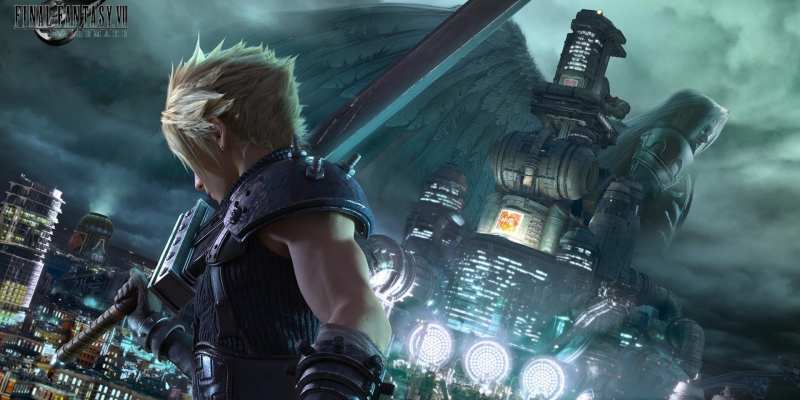It’s remarkable that not only does the first installment in Square Enix’s Final Fantasy VII Remake project exist, but it actually turned out to be a great video game. The gorgeous recreation of Midgar and the journey that Cloud and his fellow Avalanche companions embark upon feels like someone took our collective dreams from 1997 and brought them to life on PlayStation 4. But while there’s plenty to gush about regarding the world, its characters, and the narrative beginning of this grand journey, I wanted to focus on one area of the game that I almost love. Final Fantasy VII Remake’s combat is one element away from really clicking and rising to the level of the rest of the game. Coincidentally, that element exists earlier in Final Fantasy’s past.
Like so much of Final Fantasy VII Remake, the combat feels immediately and oddly familiar, like when you’re asleep and you slowly realize that you are once again in the midst of a recurring dream. The reason that the battle system draws those distinct memories is because it’s made up of elements drawn from Square’s history — both inside and out of the Final Fantasy series. The way that Cloud, Barret, Tifa, and Aerith move about the battlefield feels similar to how Noctis and company navigate the terrain in Final Fantasy XV. It’s fast, violent, and shows off an aggressive style that shares more in common with works like Crisis Core and Advent Children than it does the original Final Fantasy VII. That’s not to say that the influence of the 1997 classic isn’t here — the Materia system is a key component of both iterations and provides the clearest sense of growth and progression of your characters.
Your main goal in most battles is to discover an enemy’s weakness and use a variety of attacks to exploit it in the hopes of raising their Pressure meter. Your standard attacks are helpful in building up your own ATB meter, which allows you to then unleash distinct abilities, utilize powerful spells, or pop into your inventory and use an item. Once you’ve finally managed to max out an enemy’s Pressure, they’ll become Staggered, leaving them vulnerable and unable to attack for a brief period, as well as increasing the damage you can inflict on them several times over. If this sounds familiar, that’s because it’s one of the core elements of Final Fantasy XIII’s combat, and it is crucial in taking out some of the startlingly tough enemies throughout Final Fantasy VII Remake.

Even outside of the iconic franchise, the battle system in Remake feels like it shares DNA with a pair of other Square RPGs from the original PlayStation, namely Parasite Eve and Vagrant Story. Parasite Eve had the player freely running around dodging attacks in real-time, swapping between ranged, melee, and magic attacks, and waiting for their own ATB meter to fill before having a chance to act. Spatial awareness was a key component of Parasite Eve that remains vital to success in FFVIIR. Likewise, the classic Vagrant Story hinged on allowing the player to target specific body parts of their enemies and prioritizing where to focus their attacks — another key facet of FFVIIR.
These various systems and inspirations pool together to form an exciting combat language that is simultaneously old and new. But the one glaring problem here is that it often feels built for battles where it’s just one character versus the enemies, whereas Final Fantasy VII Remake is clearly constructed around your party of three facing challenges together. You have free rein to swap between characters at any moment, utilizing their specific strengths and skills to your advantage. Barret’s array of guns and projectiles makes him perfect against flying enemies, Aerith’s penchant for magic allows you to exploit weaknesses and attack entire swaths of enemies, and Tifa’s brutal combos feel like the quickest way to Stagger your opponents. Swapping between party members is intuitive, and each one feels like a unique and fleshed out character to control. But therein lies Final Fantasy VII Remake’s biggest problem — when you’re not in direct control of a given member of your party, they far too often feel useless.
I can’t count the number of times I switched over to another character, only to find them far removed from the center of combat. It was disheartening to be pummeling a boss bloody as Tifa, then switch over to Barret and find him perched behind a pile of rubble with his gun-arm pointed directly at the floor. It’s like your companions take a smoke break whenever you’re not inhabiting them, only to rise with a startle and quickly toss the butt aside when you resume control.

On top of this, it feels like the standard attacks they do on their own generate ATB far slower than when you’re doing those exact same attacks while in control of them. I’d fill up Cloud’s ATB meter, queue up a Firaga spell, and jump over to Aerith only to find that her meter was barely higher than when I last left her. There are small things that help, like the Auto-Cure Materia that has the wearer cue up a healing spell if any party members’ HP gets down to a certain mark, but that feels like a Band-Aid on a bullet wound. I understand and appreciate that Square didn’t want you to play Final Fantasy VII Remake as you would a standard action game and encourage regular party member swaps in a way that reimagines the classic battle formula, but it oftentimes feels like I’m playing babysitter to my fellow ecoterrorists.
The remedy to these problems is, of course, Final Fantasy XII.
The Gambit system in Final Fantasy XII allowed you to find and purchase a slew of different AI prompts that you could assign in specific orders to your party, which gave you control over their logic. For instance, you could make it so that someone uses an AOE magic attack if there are 5 or more enemies present, a character automatically uses Steal on any enemy that’s at 100% health, or specific elemental weaknesses are exploited once they’re discovered. Gambits are set up in a priority order, and the amount of equations you could attach to each character grew as the game went on. In fact, the preparation for major boss fights and discovering how various commands could work in tandem with one another became a pillar of the gameplay as rewarding as the combat itself. And once you really embraced the logic behind it and grew your arsenal of commands, variables, and situations, it genuinely felt like you were playing alongside other human beings.

Adding the ability to apply logic strings to FFVIIR party member AI would make the battles all the more dynamic. By no means would it take control away from the player — you’d still be able to swap characters at any given moment, as well as manually trigger things like Limit Breaks and Summons. But instead of losing track of your allies, growing frustrated at their lack of ATB growth, or seeing them off in the distance completely removed from the action, they’d be working alongside you in useful ways. And watching them succeed based on the string of Gambits you personally set up would provide a satisfaction equal to the actual combat itself.
The quest and progress structure of Final Fantasy VII Remake even seems built to carry the load of the Gambit system. I can imagine buying new Gambit commands at shops, trading in Moogle Medals for rare ones, or earning them for completing various side quests. Chadley’s excellent Battle Intel scenarios could provide micro goals for you to accomplish that encourage you to experiment with the flow of logic and think outside the box. And the Gambits themselves could become more varied and specified as you use them, in the same way that your Materia and weapon abilities do.
As it stands, Final Fantasy VII Remake is a bold, remarkable, and genuinely great game. It’s a miracle that after literal decades of speculation, rumors, and anxious waiting, we’re finally able to experience Midgar in its fullest form. That makes the game’s slight combat stumbles all the more pronounced. It pulls so many smart elements from previous games that it feels like the logic-based Gambits from FFXII would be the final piece of the puzzle to make the battle system truly feel like the culmination of everything that came before it. These iconic characters have lived in our memories for over 20 years; they’ve earned a right to have a mind of their own.
